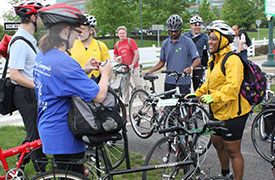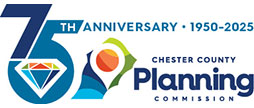Connect Goal
Advance efficient, reliable, and innovative transportation, utility, and communications infrastructure systems that responsibly serve thriving and growing communities.

Why it Matters
The infrastructure systems that connect and serve Chester County are an integral part of our past, present, and future, evolving to serve the needs of our community. These systems provide a stable foundation for economic growth and community safety.
Transportation corridors helped form the settlement patterns evident today in our city, boroughs, and villages. The advent of the automobile and creation of the National Highway System created development pressure in a more diverse pattern, propelling expansion of the suburban environment, expanding the footprint of roadway, utility, energy, and communications systems.
As we transition to digital communication, a multimodal transportation system, and a diverse energy grid, systems must modernize. Multimodal transportation networks provide options for all travel modes — vehicular, bicycle, pedestrian, public transit, and freight — and are essential to maintaining communities that support public health, provide transporatation options for all, and help to mitigate climate change. Public transit along the Keystone Corridor remains as a key spine of transport, providing connections to Philadelphia and beyond. Our proximity to Delaware River ports places the county in the position of serving as a gateway for both the distribution and collection of goods and resources.
Our infrastructure systems need to evolve to provide modern, safe, and efficient support for our communities now and into the future. Coordination of these systems with land use planning is essential.Advances in technology will have a significant impact on the design and use of all infrastructure systems. Autonomous and highly assisted vehicles, alternative energy sources, or other advances may have yet another transformational effect on how we connect. The ability to adapt our infrastructure systems to changing circumstances will be crucial.
Objectives
- Meet travel needs and reduce congestion through transportation demand management, roadway improvements, and expanded public transportation.
- Provide for the integrated development of transit-related, autonomous vehicle, automated traffic management, and other technologically driven transportation options into the overall transportation network and the land development process.
- Provide universally accessible sidewalks, trails, and public transit connections to create a continuous active transportation network within designated growth areas, and develop multi-use trails to interconnect all communities.
- Ensure that rail, aviation, and select highway facilities provide for a safe, efficient, and competitive transport of freight, goods, and people through and within the county.
- Promote safe, sustainable, and resilient energy and communications systems at the local, regional, and national level.
- Coordinate water and sewage facilities planning with land use planning so that development is directed toward designated growth areas with adequate and well maintained infrastructure.
Recommendations
- Advance implementation of transportation improvements.
- Advance multimodal transportation.
- Embrace smart transportation improvements for roadways.
- Conduct a freight study.
- Promote bus service within growth areas.
- Expand regional rail service.
- Create a countywide, interconnected trail network.
- Enhance pipeline safety and communication.
- Support a resilient and clean energy network.
- Integrate water, sewer, and land use planning.
Metrics to Measure Success
- Active Transportation Options — New active transportation options created in the county
- Public Transportation Ridership — Transit ridership within the county
- Improved Travel Time — Travel time on select highways during peak hours
- Utility Coordination — Development proposals connecting to public sewer and water services in designated growth areas




